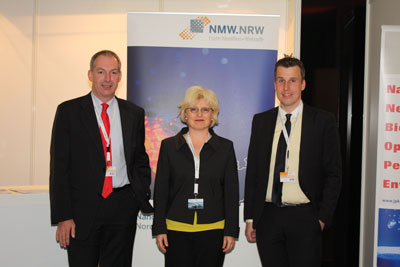 Zum mittlerweile dritten Mal traf sich anlaesslich der 6. NanoBio-Europe die internationale Nanobiotechnologie-Szene in Muenster. Rund 280 Wissenschaftler aus mehr als 20 Laendern hatten zu dem internationalen Leitkongress im Messe und Congress Centrum Halle Muensterland zusammengefunden.
Zum mittlerweile dritten Mal traf sich anlaesslich der 6. NanoBio-Europe die internationale Nanobiotechnologie-Szene in Muenster. Rund 280 Wissenschaftler aus mehr als 20 Laendern hatten zu dem internationalen Leitkongress im Messe und Congress Centrum Halle Muensterland zusammengefunden.
Jun 24th, 2010
Read more
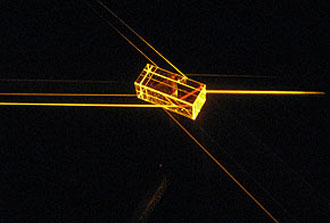 An Australian National University-led team has developed the most efficient quantum memory for light in the world, taking us closer to a future of super-fast computers and communication secured by the laws of physics.
An Australian National University-led team has developed the most efficient quantum memory for light in the world, taking us closer to a future of super-fast computers and communication secured by the laws of physics.
Jun 24th, 2010
Read more
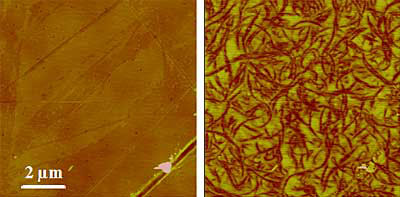 Over the past couple of decades, atomic force microscopy (AFM) has emerged as a powerful tool for imaging surfaces at astonishing resolutions - fractions of a nanometer in some cases. But suppose you're more concerned with what lies below the surface? Researchers have shown that under the right circumstances, surface science instruments such as the AFM can deliver valuable data about sub-surface conditions.
Over the past couple of decades, atomic force microscopy (AFM) has emerged as a powerful tool for imaging surfaces at astonishing resolutions - fractions of a nanometer in some cases. But suppose you're more concerned with what lies below the surface? Researchers have shown that under the right circumstances, surface science instruments such as the AFM can deliver valuable data about sub-surface conditions.
Jun 24th, 2010
Read more
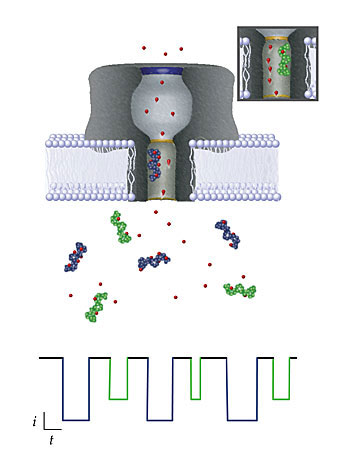 National Institute of Standards and Technology (NIST) scientists have moved a step closer to developing the means for a rapid diagnostic blood test that can scan for thousands of disease markers and other chemical indicators of health. The team reports it has learned how to decode the electrical signals generated by a nanopore - a 'gate' less than 2 nanometers wide in an artificial cell membrane.
National Institute of Standards and Technology (NIST) scientists have moved a step closer to developing the means for a rapid diagnostic blood test that can scan for thousands of disease markers and other chemical indicators of health. The team reports it has learned how to decode the electrical signals generated by a nanopore - a 'gate' less than 2 nanometers wide in an artificial cell membrane.
Jun 24th, 2010
Read more
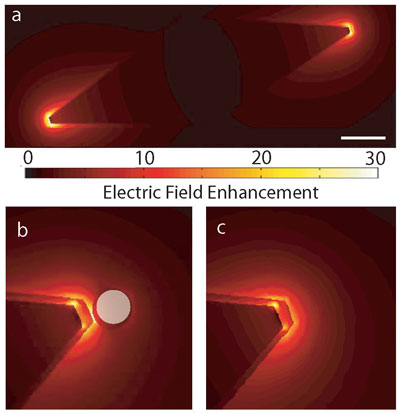 Scientists can detect the movements of single molecules by using fluorescent tags or by pulling them in delicate force measurements, but only for a few minutes. A new technique by Rice University researchers will allow them to track single molecules without modifying them - and it works over longer timescales.
Scientists can detect the movements of single molecules by using fluorescent tags or by pulling them in delicate force measurements, but only for a few minutes. A new technique by Rice University researchers will allow them to track single molecules without modifying them - and it works over longer timescales.
Jun 23rd, 2010
Read more
Not much is known about what happens to this abundant element under high-pressure conditions when it transforms from one state to another. Using quantum simulations, scientists were able to uncover these phase transitions in the laboratory.
Jun 23rd, 2010
Read more
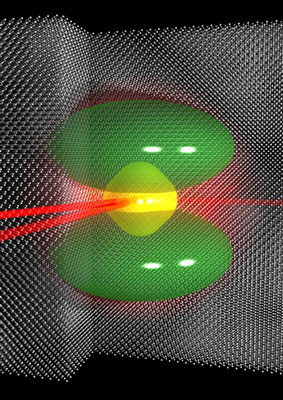 The remarkable ability of an electron to exist in two places at once has been controlled in the most common electronic material - silicon - for the first time.
The remarkable ability of an electron to exist in two places at once has been controlled in the most common electronic material - silicon - for the first time.
Jun 23rd, 2010
Read more
Worldwide nanomaterials researchers seeking the most appropriate way to solve difficult optimization problems typical of nanomaterials research can get easy to follow step-by-step instructions on how to select the best-suited local or global optimization routines, from the Numerical Algorithms Group (NAG) Library, by making use of the Decision Trees for optimization.
Jun 23rd, 2010
Read more
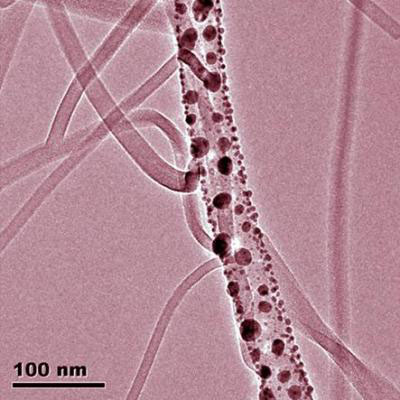 Empa scientists have developed a new method which allows them to create simple networks of organic nanowires.
Empa scientists have developed a new method which allows them to create simple networks of organic nanowires.
Jun 23rd, 2010
Read more
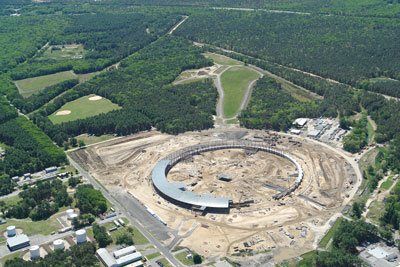 Brookhaven National Laboratory is constructing the world's most brilliant light source, the National Synchrotron Light Source II (NSLS-II). In a recent decision, DOE has approved a new project to begin conceptual design of NSLS-II experimental tools, named NEXT.
Brookhaven National Laboratory is constructing the world's most brilliant light source, the National Synchrotron Light Source II (NSLS-II). In a recent decision, DOE has approved a new project to begin conceptual design of NSLS-II experimental tools, named NEXT.
Jun 23rd, 2010
Read more
A Kansas State University chemical engineer has developed and patented a chemical structure to make all-natural personal care products and purer pharmaceuticals in the laboratory.
Jun 23rd, 2010
Read more
Professor Dr. Matthias Beller vom Leibniz-Institut fuer Katalyse in Rostock, der am 29. August 2010 anlaesslich des 3rd EuCheMS Chemistry Congress in Nuernberg als erster Wissenschaftler mit dem neu geschaffenen European Sustainable Chemistry Award ausgezeichnet wird, eroeffnet am 29. Juni in Rostock das Symposium 'Catalysis and Photochemistry for Energy Technologies'.
Jun 23rd, 2010
Read more
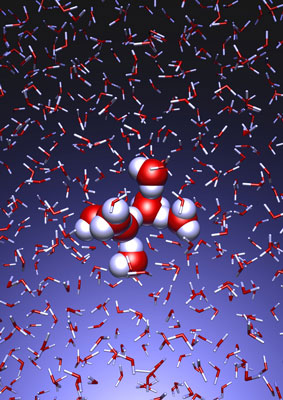 Liquid water, as well as other liquids, exhibits characteristic vibrations upon excitation with electromagnetic waves over a wide spectral range. At frequencies which correspond to infrared light, vibrational motions within single molecules can be observed.
Liquid water, as well as other liquids, exhibits characteristic vibrations upon excitation with electromagnetic waves over a wide spectral range. At frequencies which correspond to infrared light, vibrational motions within single molecules can be observed.
Jun 23rd, 2010
Read more
Increasing the efficacy and minimizing unwanted side effects of cancer gene therapy has been made possible using a new approach.
Jun 23rd, 2010
Read more
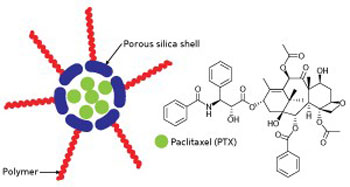 Attaching a water-soluble polymer layer to nanometer-sized silica spheres improves their mobility, facilitating drug delivery in the body.
Attaching a water-soluble polymer layer to nanometer-sized silica spheres improves their mobility, facilitating drug delivery in the body.
Jun 23rd, 2010
Read more
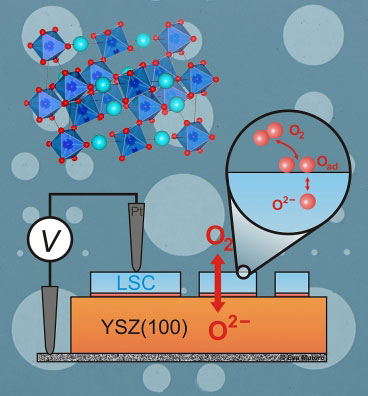 A surprising MIT laboratory finding about the behavior of a thin sheet of material - less than a thousandth of the thickness of a human hair - could lead to improved ways of studying the behavior of electrodes and perhaps ultimately to improvements in the rate of power production from one type of fuel cell.
A surprising MIT laboratory finding about the behavior of a thin sheet of material - less than a thousandth of the thickness of a human hair - could lead to improved ways of studying the behavior of electrodes and perhaps ultimately to improvements in the rate of power production from one type of fuel cell.
Jun 23rd, 2010
Read more
 Zum mittlerweile dritten Mal traf sich anlaesslich der 6. NanoBio-Europe die internationale Nanobiotechnologie-Szene in Muenster. Rund 280 Wissenschaftler aus mehr als 20 Laendern hatten zu dem internationalen Leitkongress im Messe und Congress Centrum Halle Muensterland zusammengefunden.
Zum mittlerweile dritten Mal traf sich anlaesslich der 6. NanoBio-Europe die internationale Nanobiotechnologie-Szene in Muenster. Rund 280 Wissenschaftler aus mehr als 20 Laendern hatten zu dem internationalen Leitkongress im Messe und Congress Centrum Halle Muensterland zusammengefunden.










 Subscribe to our Nanotechnology News feed
Subscribe to our Nanotechnology News feed